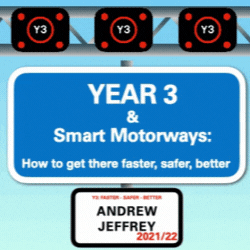Why should we be concerned about Year 3, and what on earth do Smart Motorways have to do with it?

It all started in July 2021, during a call with Liz Thomas and Deb Ferris, maths consultants for South Gloucestershire LA.
During the conversation, Deb mentioned that she was putting on some training specifically for Y3 teachers. I asked Deb she had chosen that year group specifically, and she explained that the children entering Y3 in September 2021 had had both Y1 and Y2 disrupted. It made perfect sense!
If you study the National Curriculum (2014) it quickly becomes apparent that Key Stage 1 contains more big new mathematical concepts than any other two year period in a child’s schooling.
Yet for many children entering Y3 in September, for some obvious and well-documented reasons, those two years have been very severely disrupted.
I couldn’t stop thinking about it. And as luck would have it, I was forced to self-isolate for not one but TWO ten-day periods, just a few days apart.
My sanity was in jeopardy, and I needed something to focus on. I started to think about the Y3 children in our own school, and how I might help them when we returned to school in September.
And so was born – the Smart Motorway Project. Here’s what it is…
The central premise of Smart Motorways is this: due to an extensive range of cameras and speed sensors, the computer system is able to spot problems and holdups very quickly. Not only that, but it can then slow the traffic down miles before the affected area, open and shut lanes as required, and thus avoid gridlock and potentially dangerous accidents. Ironically, slowing down means fewer delays. I’ve experienced this first-hand on the M25 and the M23, and I can testify to its effectiveness.
So the project’s aims are simple: find the big ideas that might have been missed, half-learnt, or memorised rather than understood. Spend the first 5 weeks of the autumn term looking at them, building them with resources, finding related facts and applying the correct vocabulary.
It’s a bold thing to do, for sure. Holding off on the KS2 curriculum for five whole weeks, going over things that are part of KS1. Surely there’s little enough time as it is, right?
Why on earth should we not just plough on through?
And if you’ve read this far, presumably the answer will come as no surprise. I am very confident that spending this time will help children get to their destination FASTER, not slower!
If we all get it, we can all move on. And if not, then in years 3,4,5,6 and very likely beyond, we will go at a snail’s pace because some of us aren’t at the place we need to be.
So: I went through the KS1 curriculum, and picked out 25 things to do over 25 days, each one to be revisited and reworked by children in different variations, whether it be with tens frames, Numicon, part-whole models or whatever. I made slides for the teacher and printable resources. I made sure that each lesson contained a session called “WHAT ELSE? TIME!”.
In these sessions, children had to make connections across the curriculum. So for example, on day 10, the Fact of the Day is simply:
3 x 5 = 15
But in “WHAT ELSE? TIME”, they must both build this (perhaps with Cuisenaire Rods, or tens frames, or an array) and then find as many ‘what else’ facts as possible.
I’ve provided the teacher with a few to look out for, such as the ones shown below, but the children are not limited by them. Greater depth might be achieved by the child who realises the 50 x 3 is going to be 150, for example.
5+5+5=15, 5x3=15, 15÷3=5, 15÷5=3, 3+3+3+3+3=15, and so on.
Finally I provided a few games to support and embed the learning (or re-learning) of the concept.
All of this took about three weeks to get right. And there was plenty of interest from other schools, any of whom are now also using the programme. I’ve even visited a couple, and it’s thrilling to see children engage with this so whole-heartedly.
Interestingly, in all three schools, I’ve had the same feedback: the teachers said the children claimed that they ‘already knew this‘, but when it came to showing it or relating it to the bigger mathematical picture, it became very obvious that their knowledge was often very superficial.
It’s early days of course, but I’ve been excited by the interest shown in this and I believe it has the potential to help thousands of children across the UK; there have been calls from teachers in other year groups to do something similar for them. We’ll see what lessons we can learn from this project first.
In the meantime, you can find out more here, or even come and talk to me about the project in person at MathsConf27!
